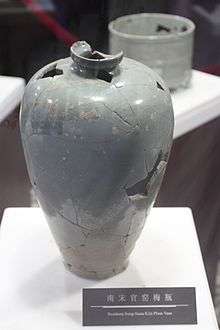Tiger Cave Kiln


Recent excavations at the Tiger Cave Kiln at Hangzhou in the Chinese province of Zhejiang have helped to identify one site of origin of the important ceramic wares of the Southern Song Dynasty known as Guan ware, meaning "official" ware, which were made for the exclusive use of the imperial court.

The Tiger Cave Kiln and other associated ceramic ware sites have come under the control of Hangzhou Southern Song Guan Kiln Museum located in the west area of Turtle Hill of Yuhuang Mountain in Hangzhou, providing a detailed appreciation of the history and aesthetics of some of China's most celebrated ceramics; the museum also contains many ceramics of other origins.
In 1127 AD, under pressure from invading Jin Tartars, the Northern Song court was driven south of the Yellow River and in 1138 AD established a new capital at Hangzhou, in the province of Zhejiang (Chu Yen 1977) (Kerr 2004). The move to the south resulted in the abandonment or decline of kilns used to make ceramic wares for the northern court, above all Ru ware, but by 1149 AD two new kilns had been built at Hangzhou to make porcelain for the newly established Southern Song court (Kerr 2004); the first kiln under the control of the Xiuneisi (Department of Palace Supply) and the second near to the Jiaotanxia (Altar of Heaven) (Chu Yen 1977).
The location of the Jiaotanxia kiln was finally established by excavations carried out between 1984 and 1986; but the location of the Xiuneisi kiln remained unknown until excavations started in 1998 at the Tiger Cave kiln site provided confirmation that this was the hitherto unidentified Xiuneisi kiln (Kerr 2004).
Excavations at the site

From 1998 to 2001 the Hangzhou [杭州] Hangzhou Archaeological Institute of Cultural Relics [杭州市文物考古所] excavated the Laohudong (Tiger Cave) Kiln [老虎洞窑]. The results have rewritten Chinese ceramic history and solved mysteries that have haunted the field for literally hundreds of years. Excavated shards fall within the historical range of the Southern Song Dynasty (1127-1279) to the Mongol Period (1271-1368). The Southern Song celadon sherds show clearly that the Tiger cave Kiln was the ceramic production site for Southern Song official (guan) ware [南宋官窑]. Tiger Cave is a seven hundred meter area located between Phoenix Mountain and Nine Flowers Mountain. The site is not more than a hundred meters from the north wall area of the Southern Song Imperial City area. Likewise it is two and a half miles from another Song production area known as the Jiaotan Official Ware Kiln [郊坛下窑].
The discovery of the Kiln site took place on September 20, 1996 after an extensive archeological search of the area. Southern Song shards display shapes that correspond to ritual vessels such as celadon vases and incense burners. Clearly the original objects were intended for palace use. The shards are primarily of a powder blue color. Next in number are those of a honey tint. The celadon shards display a rich thick glaze with prominent crackle and crazing. Clearly the kiln site is the long lost Official Ceramic Ware site referred to in historical texts as the Xiuneisi Official Ware Kiln [修内司窑]. The Mongol Period strata of the archaeological site perhaps solves another long standing ceramic history mystery i.e. that of Ge ware. After the fall of the Southern Song court and the unification of the Chinese nation under Mongol rule the Tiger Kiln maintained production. A portion of the ceramic production of this period continued to be celadon ware in the official (guan) ware style. This conforms to period historical references.
Southern Song guan wares
The Percival David Foundation has in its collection, now in the British Museum on loan, a number of pieces that some scholars believe were made at the Xiuneisi (Department of Palace Supply) kiln; a kiln which has now been identified as the Laohudong (Tiger Cave) kiln.
References
- Chu Yen, T'ao Shuo (Description of Pottery), translated by S.W. Bushell, Oxford University Press, Kuala Lumpur, 1977.
- Du Zhengjian, 'The Kiln Site of Tiger Cave Kiln', Wenwu tiandi, no. 5, 2005, pp. 44–53.
- Kerr, Rose. Song Dynasty Ceramics, V&A Publications, London, 2004.
- Kotz, Suzanne (ed.) (1989) Imperial Taste. Chinese Ceramics from the Percival David Foundation. Chronicle Books, San Francisco. ISBN 0-87701-612-7.
- Wang Guangyao, Zhongguo gudai guanyao zhidu (China's ancient system of official kilns), preface by Quan Kuishan, Beijing: Zijincheng Chubanshe, 2004, 214 pp.
External links
| Wikimedia Commons has media related to Southern Song Dynasty Guan Kiln Museum. |
- Hangzhou Southern Song Guan Kiln Museum
- A Handbook of Chinese Ceramics from The Metropolitan Museum of Art